In April’s newsletter, we had an article SheADV Training Fundamentals, where we talked about researching training schools, instructors and riding both on and off the street. This article is the next step to improving your fundamental skills for both on-road and off-road riding. Mastering your skills and maintaining them, make riding easier and most importantly, it increases your FUN FACTOR.
The following 5 skills are critical for not only mastering your motorcycle, but also for your survivability for both on and off the road.
Bobbie, Director of State Programs
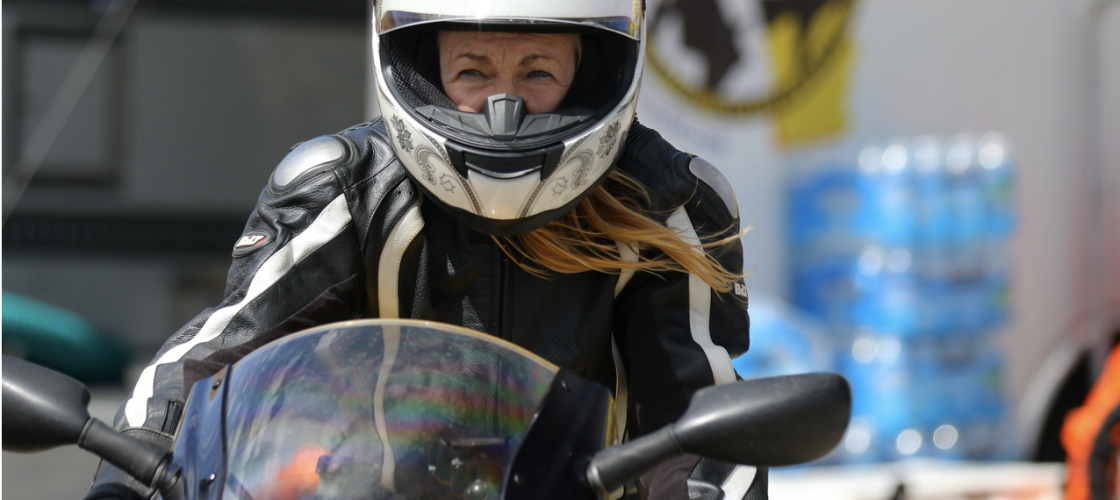
1. Slow Speed Riding (<15 mph)
Riding slow is difficult. Master riding slow and it will make all other riding easier. It’s not hard to twist the throttle and make the bike go forward and fast.
Riding slowly takes skill. Riding slowly is performed the same way whether you’re on or off the street.
HOW TO PRACTICE
✦ Clutch, throttle, and rear brake interaction
✦ Rear brake helps sets you into the ground and stabilizes the bike
✦ Throttle, just enough to give the clutch something to work with
✦ If you feel like you need to put your foot down, you closed the clutch too much, get back into the clutch
✦ Using the clutch continuum (+5=clutch all the way out, -5=clutch all the way in, zero=where the bike starts to move)
✦ Take the clutch to +1 or +2, as the bike starts to move, add a bit more throttle to stabilize the bike and allow the bike to pull you along while trying to go as slow as possible
Master the clutch and you master the power to the rear wheel, which allows you to control your motorcycle better.
Shalmarie, Professional Traffic Safety Instructor
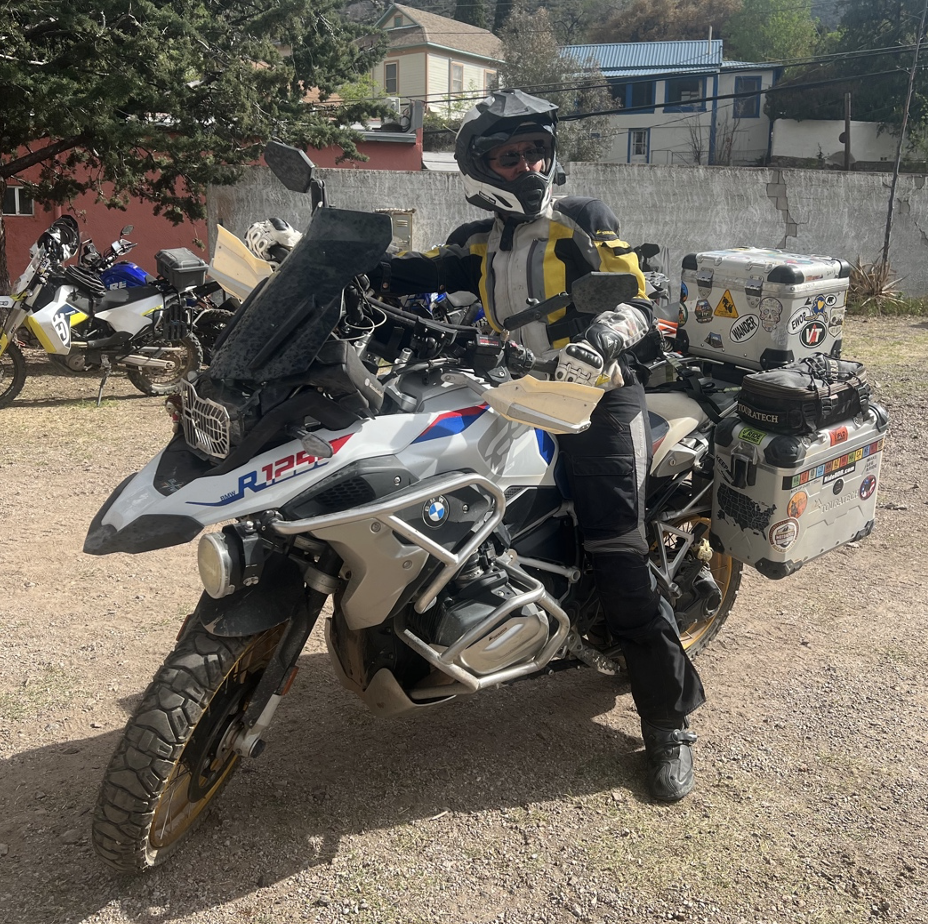
2. Sharp turns from a stop
Many riders avoid mastering this skill and won’t come up to a complete stop, especially at a stop sign and having to take a right-hand turn. Instead, they do the rolling stop, which could end up inserting them into traffic someday. I find myself doing the same thing, so this past season, I’ve forced myself to practice doing sharp turns from a stop. The sharp turn from a stop is a challenge because you need to turn sharply and make a smaller radius turn, while also avoiding the power of the motorcycle that is forcing you to the outside of your turn and potentially taking you into oncoming traffic or forcing you too close to the cliff or worse, off the cliff. The other challenge to this maneuver is closing the clutch and then dropping the motorcycle. Sharp turns from a stop are performed the same way whether you’re on or off the street.
HOW TO PRACTICE
✦ From a stop and a full lock turn
✦ Point your chin where you want to be going next
✦ Extend your inside arm, pushing the bike towards the turn
✦ Plant your inside foot, while leaning your upper body/shoulders to the outside
✦ Using the clutch continuum (+5=clutch all the way out, -5=clutch all the way in, zero=where the bike starts to move)
✦ Take the clutch to +1 or +2, as the bike starts to move, add a bit more throttle to stabilize the bike and allow the bike to pull you forward
✦ Don’t release the clutch all the way until you are well under way in your intended lane or path of travel
Practice this skill until your body positioning (chin pointing, inside foot planted, shoulders to the outside of the turn, inside arm extended) feels natural. Now, on my bike, because it is tall and heavy, I can’t lean it too much or I will drop it, but I do these steps as much as I can and I am still able to turn the bike within a 12-foot radius, which is the average radius of a highway lane. The key is clutch control.
Student from a Dragoo Adventure Rider Training course
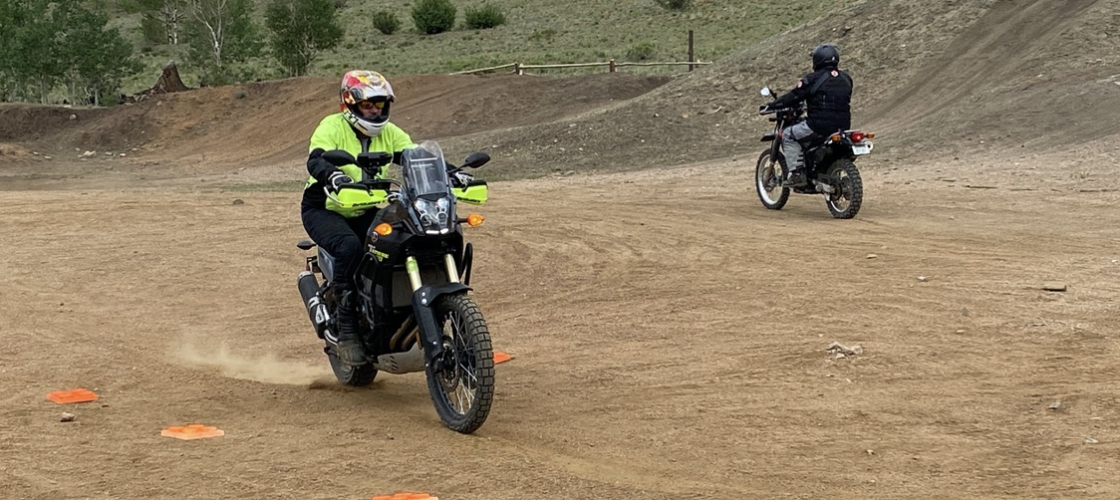
3. Quick Stops – higher speed braking
The goal is to stop as quickly and safely as you can without skidding either tire. However, when doing quick stops off street and you are on varied, loose surfaces, you will skid. Because you will skid when preforming quick stops off street, know that your total stopping distance is going to be greater than it would be if you were on the street with better traction. This is one of the reasons riders should manage their speeds more when riding off the street.
HOW TO PRACTICE
✦ First start with speeds at around 15 mph and once you’re proficient at 15 mph, then slowly build speeds up in small increments
✦ Pick a predetermined stopping point ahead and apply front and rear brake simultaneously along with squeezing the clutch lever. Stop as quickly and safely as possible without skidding either tire
✦ Squeeze the front brake smoothly and firmly, with increasing pressure
✦ As you start to slow, squeeze the front brake MORE, MORE, MORE (that’s what will stop you faster, keep increasing pressure on the front brake)
✦ Use light to lighter pressure on the rear brake, because as the weight transfers to the front, the rear-end gets lighter
✦ Get to first gear and come to a complete stop, if you don’t come to a complete stop, you won’t do it in the event of an emergency. We do what we practice
✦ Bars must be square, head level with the horizon and your eyes looking forward, knees tight to the tank
✦ Once stopped, left foot goes to the ground while keeping the right foot on the brake. When off street, there might be times you need to put your right foot down after coming to a complete stop as the terrain might be sloping away and make you drop the bike if you were to put your left foot down.
When it comes to off road quick stops, different curriculums teach different methods and over the years, I have found that practicing quick stops, whether I’m on the street or off the street, using the same method makes sense to me. It’s about muscle memory, and in the event, you must stop quickly, you want to be able to go right into the skill and not have to also be remembering what surface you are on. If you have ABS and other traction controls, play around with the different modes while on different types of surfaces and find out what works best for you. If the technology is there, use it. I find having ABS on is better for certain surfaces and ABS off for other surfaces. If you are riding more aggressive and want to be doing power slide turns, then of course, you’d want your ABS off. But for normal riding, whether it’s on or off the street, for me, having ABS on makes a lot of sense. Now, when it comes to rougher terrain and hills, turning the ABS off will help manage those kinds of conditions better. The bottom line is to play with your modes (if you have them) and find out what works for you. Understanding your bike and how it works is extremely important for you managing your bike.
Colleen, Professional Traffic Safety Instructor for Total Control
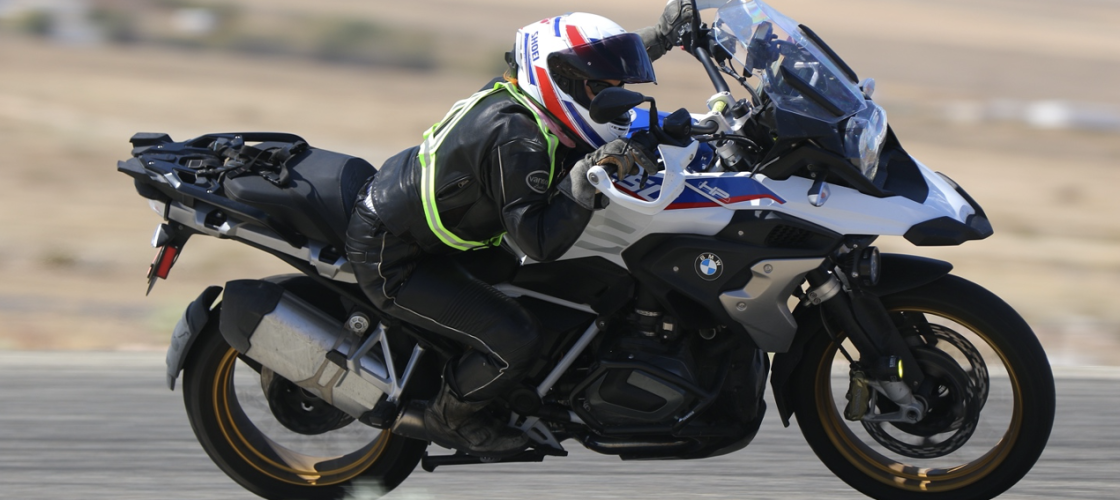
4. Countersteering – push FORWARD steering for road speed turns (15 mph +)
HOW TO PRACTICE – (first start with straight line swerving, since swerving is two consecutive countersteering actions, this will give you a better understanding on just how effective pushing FORWARD on the handlebars really is)
STEPS FOR SWERVING
✦ Accelerate in a straight line at least 15 MPH to start, once proficient at 15 mph, then slowly build speeds up in small increments
✦ Pick a spot ahead (I often use manhole covers, but I recommend that you start in a parking lot) and as you approach it, push FORWARD on the handle in the direction you want to go and swerve around it
✦ Push FORWARD on the handlebar in the opposite direction to straighten the bike back out
✦ The first FORWARD push should be held a bit longer then the second push to ensure you avoid the obstacle by a further distance
Swerving is a crash avoidance skill that could save your life, so practice this skill often. That is why I often use manhole covers because you shouldn’t ride over them as they may or may not have been screwed down in place properly and they tend to be hard to see so when you approach them, you have to respond quite quickly. Once you can feel and understand this maneuver, use countersteering (push FORWARD on the handlebar in the direction you want to go) to initiate your turn while doing road speed turns. Push FORWARDon the left handlebar to go left and push FORWARD on the right handlebar to go right. Speeds below 15 mph will require more of a direct steering input, which is turning the handlebars and pointing the front tire in the direction you want to turn. Like you’d do for a turn from a stop. To use countersteering, you must be going at least 15 mph.
Countersteering While Cornering on the Street at 15 MPH+
Once you have practiced countersteering in a straight line, use the same technique for road speed turns. It is a fact that you can obtain your motorcycle license without ever really understanding countersteering. This is unfortunate, because ineffective countersteering is a major contributor to many motorcyclists crashing all by themselves with no one else around to blame. This is a skill you use all the time and must be proficient to be a safe motorcycle rider. Many riders push down on the handlebars, which is ineffective. It certainly does make the motorcycle turn, but it’s a S-L-O-W way to get the bike to turn, which is why many riders go off the road and crash.
To initiate the turn, use a smooth, firm FORWARD push. Once the motorcycle is into the turn, you direct steer using your inside arm to control your line, while keeping the outside arm relaxed.
For off street riding, it’s important to understand that you want to always be weighting the outside peg and using more of a direct steering input, so countersteering isn’t something you do when you’re riding off the street. If you were to countersteer and lean into the turn like we do on the street, the bike could very well slide out from under you. Weighting the outside peg gives the tires more traction and in the event the bike were to side out a bit, you are in the right position to keep to from sliding out from underneath you. Note: for more advanced riding, the technique would be different.
Training at a Total Control Track Clinic
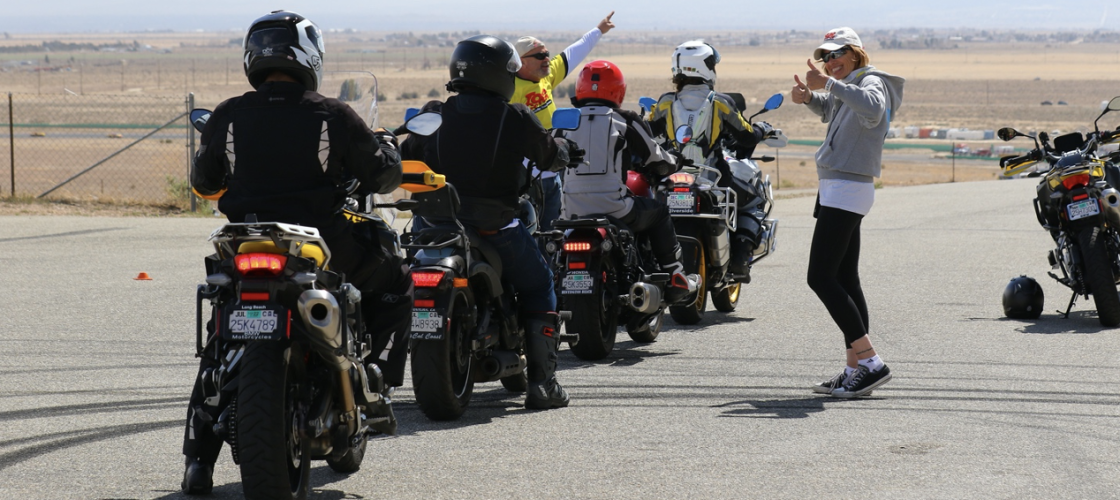
5. Mental practice
The final and most important skill to practice is mental processing, believe it or not, it does take practice. Riding is more about the eyes and mind, then it is the hands and feet. For new riders, it’s of course going to be about the hands and feet, but once they can locate and use the controls without looking at them, riding becomes more about the eyes and the mind. It takes practice to always be mentally aware, aggressively, and continuously scanning for all the potential hazards and having a plan on how you’re going to manage the risks. In the MFS curriculum, we teach to use the acronym SEE (Search, Evaluate and Execute) to remember the mental process. In Total Control, we teach the A3 Strategy (Awareness, Assessment and Action). Whether you use one of these processes or come up with you own, like “What’s next, have a plan and stay present,” have some kind of method to help you stay focused and alert. The only way you will properly respond to a situation is by practicing all these 5 skills regularly to the point they are muscle memory. Once you get to this point, you can ride more relaxed and be able to respond properly to any sudden changes in your path of travel. Ride relaxed, but always stay vigilant.
According to the 2020 reports from the National Highway Traffic Safety Administration, motorcyclists are 28 times more likely to die per mile ridden verses per mile driven. It was also reported that we represent 14% of all the fatalities, even though we account for only 1% of the vehicles on the roads. These are staggering statics and the highest percentages seen since 1975! This is way the mental processing of riding is the most important skill you can have. Now, because we are human and we can get distracted and miss critical information, having the skills to make evasive maneuvers, like quick stops and swerving, at a moment’s notice is what will help keep you from being the striking vehicle. According to the Total Control curriculum that I teach, 96% of the time motorcyclists are the striking vehicle. We aren’t always at fault, (however 76% of the time we ARE at fault), but we are the ones who pay the high price to having a collision. In my opinion, one of the reasons that number is so high is because riders don’t practice the mental processing along with crash avoidance skills and when PDL (pure dumb luck) runs out, they strike! Increase your skills, increase your safety, and most of all, INCREASE YOUR FUN FACTOR!
I hope you find these 5 skills valuable and that you practice them regularly. Remember this is a sport and like all other sports, we must practice and practice often to be any good at it. In our case, we not only will master our bikes better and increase our FUN FACTOR, but we increase our overall survivability.
Ride skilled. Ride well. Ride old.
For more info about SheADV check out our website!
This article is not intended to replace in-person, professional instruction, and training courses. It’s informational only. There are a lot of different things doing on with each skill, including body position, the use of the controls and vision that cannot be instructed by just reading an article. Sign up for a professionally taught class and learn as much as you can on how to manage your motorcycle. Motorcycling riding is a life-long learning sport.
Shalmarie Wilson is a professional on and off-street instructor certified in both Total Control and Motorcycle Safety Foundation.
